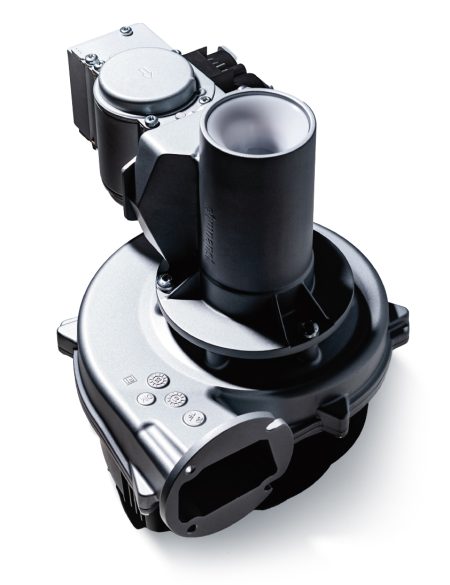Mr. Gieron, why did ebm-papst develop the RadiMix HS 122?
We wanted to create a new standard for commercial applications. A gas/air composite consisting of blower, venturi, valve, and combustion controller that is suitable for all condensing units in the 80 to 150 kW power range.

What is the advantage of the composite system?
In order to achieve the most efficient combustion possible, the right gas/air ratio is crucial. There must be enough air available to keep pollutant emissions to a minimum. However, if the air content is too high, this results in low efficiency. Our development engineers can coordinate the components in such a way that they fit perfectly with the applicable device.
What is special about it?
For this power class, it is the most compact gas/air composite system on the market! We made many adjustments, but the decisive factor was the development of a completely new blower, the VG 122. Now we can achieve 150 kW even at higher back pressures.
At the same time, we have increased the modulation range to 1 : 10. We were also able to minimize the noise generation.
10.000 rpm
Maximum speed
H2
ready

1:10
Possible modulation range
150 kW
Achievable heating power
How did you manage to get so much power in so little space?
We optimized the blade geometry and adapted it to the housing to create an ideal flow geometry. In conjunction with a new EC motor, we have therefore succeeded in increasing efficiency. Manufacturers can now make their devices much more compact. All in all, we have created a future-proof product.
15%
less installation space is taken up by the blower. The RadiMix HS 122 is thus the most compact gas/air composite system in its power class.
In what sense is it future-proof?
Firstly, because we have exploited everything that is technically possible today and secondly, because we have already taken future applications into account. All components of the system are already suitable for admixing up to 20 percent hydrogen to the gas content. This means a fast and effective contribution to curbing CO2 emissions. We are currently working on a system consisting of the VG 122, our G32 G01 gas valve and the BCU 110 control unit that will allow us to burn 100 percent hydrogen. In the field of commercial building technology, I see an opportunity here to put sustainable system solutions in place for the energy transition. Terminal devices are usually located in places where other heating systems are difficult to install.

Leave a comment